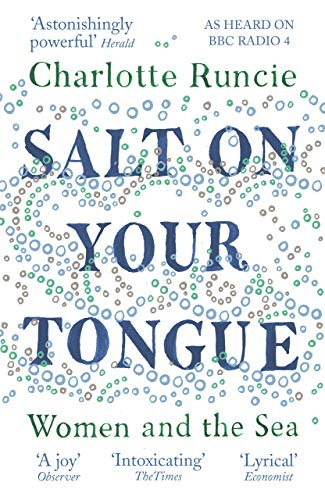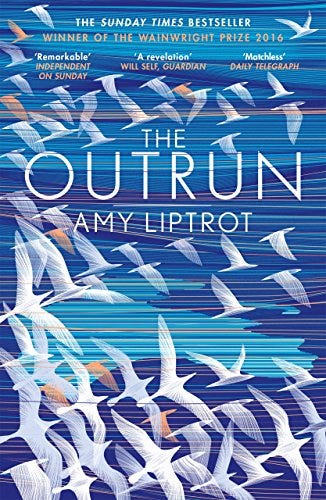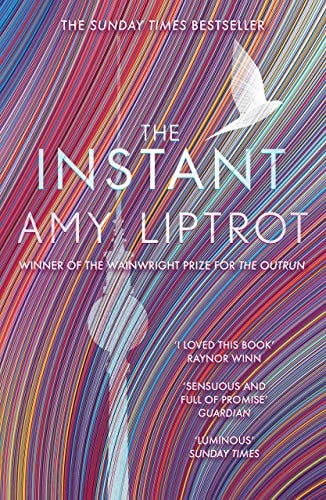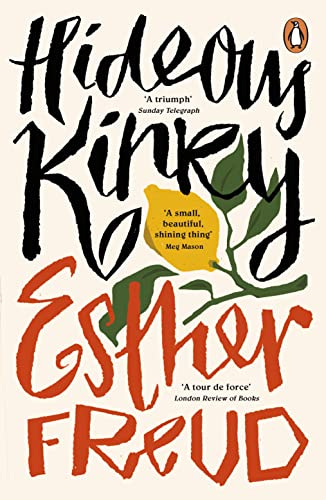
Welcome to A Narrative of Their Own, a weekly newsletter celebrating the lives and literature of women.
If you enjoy reading essays on literature as well as monthly reviews, please consider a free or paid subscription.
This week, I thought it would be fun as the end of term has just descended on the UK for the majority of schools and thoughts turn to travels and holiday getaways, to look at a few of my very favourite ‘travel’ books.
(Please note: I am using this term loosely to indicate books that make good travelling companions, rather than books necessarily about travel!)
Salt on your Tongue by Charlotte Runcie
Perfect for: a trip to the British coastline
“Being British comes with a catalogue of sea-themed cliches,” writer Charlotte Runcie muses in Salt on your Tongue, a book that was referred to as ‘An ode to the ocean, and the generations of women drawn to the waves or left waiting on the shore’, by The Guardian.
Runcie elucidates this by mentioning eating “fish and chips on the beach, or in the car while the rain pelts down, ‘Rule, Britannia!’ at the BBC Proms, the shipping forecast playing out over and over every night”, as items quintessentially linked to a British seaside holiday. As someone who usually holidays at home, I can attest to these images.
What is interesting about Runcie’s exploration of all things sea related is her insistence that, had she grown up in a landlocked country, she believes this “saline connection” would not have developed.

Salt on your Tongue is Runcie’s memoir of her deepening attraction to the sea during her pregnancy, aged 28. This obsession develops throughout the book, leading her to take an increasingly feminist stance towards the sea, stating: “The call of the sea is the call to the absolute strength of women, telling their stories and making music of beauty and imagination, and eternal mothers and grandmothers making eternal daughters and rocking them in the night as they sing while the tide comes and goes.”
But Runcie does not discount man’s attraction to the sea: she expresses her adoration for John Masefield’s poem ‘Sea Fever’, for example, however increasingly finds that her pregnancy draws her focus away from sailors toward the women who traditionally waited on the shore: “The voices of people whose lives are shaped by the sea without them ever walking across it.”
The book is split into seven sections, each one fronted by a female figurehead named after one of the stars of the Pleiades: Alkyone who drowns and becomes a kingfisher; Kelaino, loved by Poseidon and tied to the sea; Elektre who marries the sea god Thaumas and gives birth to the rainbow goddess, Iris. Following the timeline of her pregnancy, Runcie discovers the threads of representations of the sea in literature, folklore, painting, and sea-shanties.
Runcie has a wonderful poetic prose which appears to imitate the ebbing and flowing of the tides, and her evocation of the waves and wild landscape of British beaches always makes me long for a windswept walk along the rocks and sandy shores of our coastline.
Runcie associates herself with painter Joan Eardley, who painted one of her favourite paintings The Wave in 1961 and who died of breast cancer aged 41. Eardley’s ashes are scattered on the beach at Catterline and her paintings hang in the National Galleries of Scotland; Runcie herself later resides in Edinburgh.
But the book also examines Runcie’s anxieties over her pregnancy and the way her body becomes a vessel - “a mobile aquarium” - for her unborn child, causing her to dwell on death. As she tries to communicate with other pregnant women about her stretch marks, she is told they have none, leading her to consider whether she is a different species, “a mermaid covered in scales.” Her mother provides some much needed perspective however, informing her that the other women are just lying to her, and that the marks will fade over time.
Runcie writes beautifully about her grandmother, from whom she says she inherits a love of music and the sea, and though her grandmother is deceased, she forms an ever-present character within the pages of the book.
This one is a beautiful exploration of what it means to take on the responsibility of carrying the next generation, the ways in which legacies are handed down - woman to woman - and our connections to the myths and legends of the sea. Perfect for reading on a rugged British beach!
Amy Liptrot The Outrun
Perfect for: a remote island getaway
I raced through Amy Liptrot’s first book of memoir, The Outrun, when I came across it several years ago. Planning for an upcoming writing event I was invited to read at, I thought I ought to engage with the book since Liptrot was headlining the event.
What I found was a beautifully written memoir of the author’s return to her Orkney home in order to heal from alcoholism. Although Liptrot was dealing with her demons as she wrote the book, the nature writing within it - as well as her honesty about her own life - is captivating.
Liptrot, born in the Orkney’s, has been living in Hackney, London, where her fast living has led to an alcohol dependency. Desperate to recover from this, she returns to Orkney, renting a tiny cottage on Papa Westray, and using her homeland as a way to meditate on identity and place and overcoming her addictive nature.
The Outrun of the title is a piece of land on which her father lives in a caravan. Odd sorts of things happen there, such as a ship becoming grounded on the cliffs with the islanders (like something out of a Daphne du Maurier novel) asserting their rights as wreckers, as well as sea fowl wheeling and cawing overhead.

Liptrot shares her worries around her father, whom she says struggled with bouts of mania throughout her childhood, resulting in his hospitalisation. She uses shifting tenses between past and present to create a picture of family life on Orkney, where her parents separated and her mother moved to the islands’ main town. Liptrot ‘escaped’ to Hackney, where she indulged in drugs and alcohol and a hedonistic lifestyle.
She vulnerably shares her losses - of jobs, a boyfriend she loved, her health and self-respect - finally ending up in rehab. Now alcohol free but still struggling, she has retreated to The Outrun to recover and write.
Liptrot also works on her father’s farm and gets a job surveying the endangered corncrake. Interestingly, in Papa Westray, Liptrot uses technology to enhance her engagement with the natural world, writing wonderfully about the experience. She walks, dances between the standing stones, joins a wild swimming club and, eventually, recovers something of her natural identity.
As a follow up:
The Instant by Amy Liptrot
Perfect for: a city break
Liptrot returns with a follow-up memoir, The Instant, in which she again writes vulnerably about her life as she leaves the Orkney’s to spend time in the city of Berlin, seeking love and connection. She also manages to blend in aspects of urban nature, juxtaposing this with life and all its messiness. Her writing, as ever, is raw and honest.
Liptrot details her travels to Berlin as an escape from the isolation of Orkney. She focuses in this memoir on loneliness and the intention to find love. Much of the second half of the book details a romance between Liptrot and a man she meets in Berlin, and the fall-out from that relationship, and although I did find that it laboured the theme of a broken relationship for too much of the second half of the narrative, clearly this deeply affected Liptrot, and the simplicity and beauty of her prose carries the rest of the book. I also think she represents an area of writing which has long interested me: that of the Flȃneuse; the female writer wandering the city streets and writing about their experiences. The Instant would be an ideal accompaniment to a city break, particularly in Europe.
Hideous Kinky by Esther Freud
Perfect for: backpacking or long-haul travel
Hideous Kinky is a 1992 semi-biographical novel by Esther Freud about two young English girls living in the chaos of late 1960’s Morocco while their well-meaning hippie mother pursues enlightenment.
The unnamed Narrator, (based on Freud’s own childhood), is a four year-old English girl who travels with her mother and six year-old sister Bea to 1960’s Morocco. Once there, they live a hand-to-mouth existence as their mother waits for money from the girls’ estranged father.
Their mother then begins a relationship with a handsome street performer, Bilal, and the girls adopt him as a surrogate father. When Bilal goes to Casablanca in search of work, their erratic mother decides to move to Algiers to study Sufism. Older sister Bea, however, insists on attending school in Marrakech, and the young narrator and her mother leave her in the care of guardians.
After a dangerous journey, eventually the narrator and her mother return to Marrakech for Bea’s birthday, discovering that her guardians have moved away. They track Bea down at a missionary school run by a devoutly Christian woman, who criticises their mother’s parenting.

Bilal returns from Casablanca, whereupon Bea becomes ill, forcing Bilal and her mother to beg for money on the streets. Using the money they get, their mother purchases return tickets to England, and they say goodbye to Bilal.
The book was the debut novel of Esther Freud, aged 26. She admitted to the autobiographical nature of the book, detailing her experience of living in Morocco with her mother Bernardine Coverley, and older sister, Bella, whilst their father - the painter Lucian Freud - stayed behind in London.
Freud delivers an astonishingly vivid depiction of Morocco through the eyes of a four-year-old child, giving an important perspective of the life of the child of a woman who has chosen to follow the hippie-trail of 1960’s travel.
After the book was released as a film in 1998 starring Kate Winslet as the mother, it further raised the profile of the book. The film did well, despite being an independent British release, due in part to Winslet’s recent success in the blockbuster Titanic.
Freud’s story is an engaging one and encompasses a cast of interesting characters. It also has the advantage of the actions of adults being seen through the often naive and bewildered eyes of a child, causing some moments of tension for the adult reader who anticipates the dangers that these children may be in.
Because of the child narrator, we see the mother through her eyes, kindly, rather than judgmentally as an older child or adult may have been at her mother’s dubious choices. Some of the mother’s actions, for example caring for a crying baby or buying dresses for the street children in Marrakech, allow for an empathy with the mother which could otherwise be overlooked when witnessing her sometimes thoughtless choices.
The book also contains a lot of fun as the children run around freely through the streets; a level of freedom they might not otherwise have ever experienced. Freud shows an overview of her childhood through her four-year-old narrator with a great deal of empathy towards her mother, whom she portrays as a flawed but generous woman.
As I discussed in last week’s third essay in my ‘Summer of Love’ series, the book exposes some of the counterculture of the 1960s that writers like Joan Didion were uncovering in the USA.
So there are three (ok, four!) of my favourites. There are of course many, many others. I would love for you to share the ones that you would (or are) packing for summer wanderings in the comments!
Free subscribers receive my weekly researched essays every Sunday, as well as access to community threads.
Paid subscribers also receive my monthly reviews, where I delve into great reading, writing, and watching. A paid subscription works out at less than £2 per month for the yearly fee, helping me to research and celebrate the important words of women.
Thank you for your support 🙂







Great idea! Both for books and places to holiday 😁
I forgot about 'Hideous Kinky'! I didn't realise it was semi-autobiographical. It's always so interesting when a book is told from a child's point of view - it gives us a new perspective on what happens in the novel. I can relate to Charlotte Runcie's pull to the sea - I'll have to check out her book. Great suggestions :)